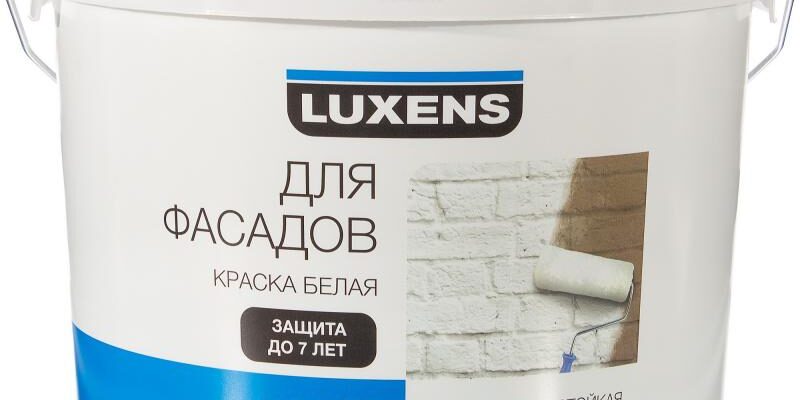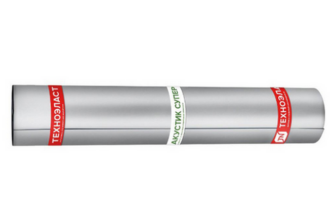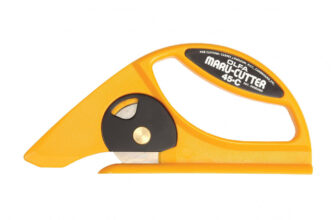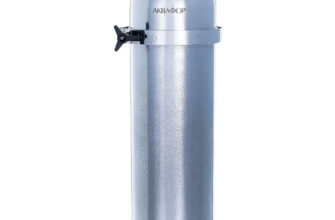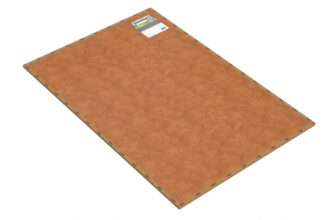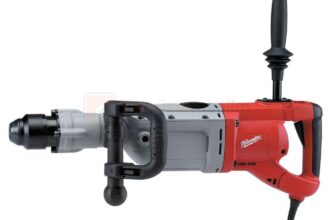Review of the best according to the editorial board. On the selection criteria. This material is subjective and does not constitute advertising and does not serve as a purchase guide. Before buying, you need to consult with a specialist.
Not only the exterior of the house depends on the quality of the facade paint. Of course, nobody likes peeling walls. However, facade paint is not only a decorative material. It also protects walls from mold, mildew and decay. And their aggressive action is much more unpleasant than just a peeling facade. So its choice should be approached with all responsibility.
| Nomination | a place | Name of product | rating |
| Rating of the best facade paints | 1 | Luxens Facade | 4.9 |
| 2 | Tikkurila Ultra Matt | 4.8 | |
| 3 | Facade expert | 4.8 | |
| 4 | Tex PF-115 | 4.7 | |
| 5 | Façade Deluxe Scanmix | 4.7 | |
| 6 | Caparol AmphiSilan-Plus | 4.6 | |
| 7 | VGT VDAK 1180 SuperWhite | 4.5 | |
| 8 | Akrial-Lux | 4.5 | |
| 9 | Lacre | 4.5 |
We have compiled a rating of the 9 best facade paints that are suitable for both wooden and brick houses.
- How to choose a facade paint
- Types of facade paints
- Tips for choosing facade paint
- Rating of the best facade paints
- Luxens Facade
- Advantages
- disadvantages
- Tikkurila Ultra Matt
- Advantages
- disadvantages
- Facade expert
- Advantages
- disadvantages
- Tex PF-115
- Advantages
- disadvantages
- Façade Deluxe Scanmix
- Advantages
- disadvantages
- Caparol AmphiSilan-Plus
- Advantages
- disadvantages
- VGT VDAK 1180 SuperWhite
- Advantages
- disadvantages
- Akrial-Lux
- Advantages
- disadvantages
- Lacre
- Advantages
- disadvantages
How to choose a facade paint
Types of facade paints
When choosing a facade paint, you should first of all pay attention to its type. Distinguish:
Vinyl and polyvinyl acetate;
- Acrylic;
- Acrylic silicone (latex);
- Silicone;
- Silicon (silicate).
Vinyl and polyvinyl acetate paints are a versatile solution with a low price. But it is worth considering that they shrink a lot when dry and are not very resistant to mechanical stress, so they are poorly suited for covering budget plaster.
Acrylic facade paints, due to their increased mechanical resistance and low shrinkage, are excellent for wooden facades, as well as for other materials on a mineral or organic basis. But due to their low vapor permeability, they are not suitable for lime plaster.
Latex façade paints are highly flexible and have excellent vapor permeability, making them suitable for all types of substrates. However, due to their high absorbency, the surface covered with them quickly gets wet and easily gets dirty.
Silicone facade paints are hydrophobic, vapor permeable and have excellent adhesion. But they are prone to burnout. However, these paints reliably protect the base of the facade from any negative influences.
Silicate facade paints are characterized by maximum adhesion (it is so strong that they will have to be removed during restoration together with the plaster) and effectively protect the facade from mold. However, they are not suitable for organic – for example, wood – base.
Tips for choosing facade paint
Some tips for choosing the right facade paint:
- Very cheap solutions should be avoided. They are likely to contain a lot of solvent;
- In general, the more binder, the better;
- The spreading rate of the facade paint must be at least 100 grams per square meter;
- It is recommended to choose the paint depending on the plaster used;
- To cover the facade, which is exposed to direct sunlight, it is better to choose light-resistant paints (acrylic, acrylic-silicone, polysilicon);
- Glossy paints have greater lightfastness than matte ones, but at the same time they have low vapor permeability and do not mask façade coating defects.
Rating of the best facade paints
Luxens Facade
Rating: 4.9
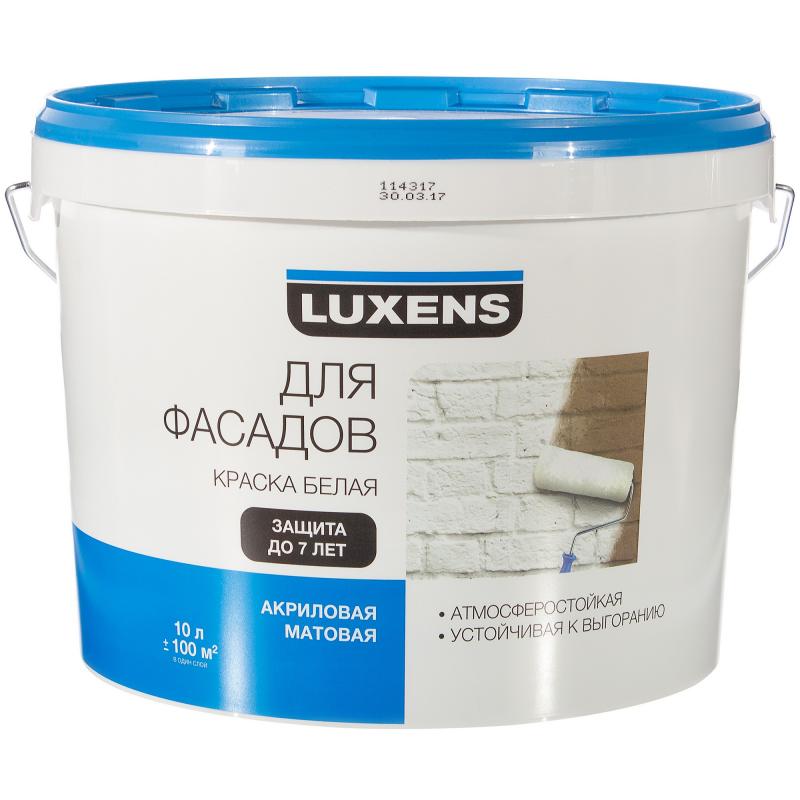
Why it is: The base of the paint is acrylic thermoplastic resin.
Facade paints from Luxens are based on an acrylic thermoplastic resin, making them suitable for all substrates. The balanced composition, including – in some variants – titanium dioxide, provides excellent reliability. Paints are resistant to temperature, weather and mechanical influences, do not fade, and are hydrophobic. And the facades covered with them can be washed – if, of course, the need arises.
The paints are compatible with all inorganic substrates. However, at the same time, they are not very suitable for wooden facades – which, in principle, is due to the acrylic base. It does not bond well with organic surfaces.
According to information from the manufacturer, the service life of these materials is up to 10-20 years, depending on the specific type. Available only in white, but compatible with tinting pastes.
Advantages
- Resistance to weather, liquid, mechanical stress;
- Non-toxic, suitable for medical institutions;
- Good adhesion, low shrinkage.
disadvantages
- Tinting paste required (presented only in white);
- Long complete drying, but the drying of the layer – 2-4 hours.
Tikkurila Ultra Matt
Rating: 4.8
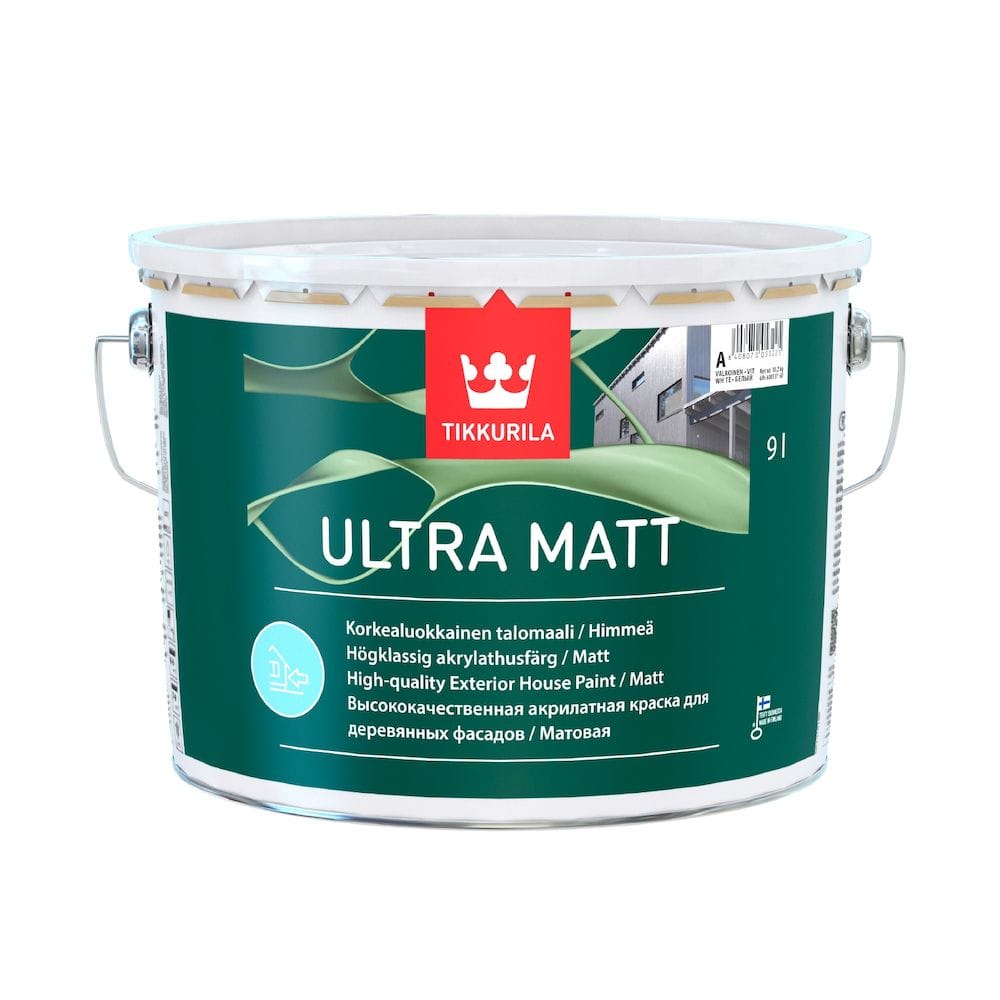
Why it: Suitable for wooden facades and untreated surfaces.
This polyacrylate based paint not only has excellent weather resistance, but is also suitable for use on untreated surfaces. That is, it can be used on wood facades that have not been previously primed. It can also be applied over a layer of old paint. Of course, it is also compatible with primed surfaces.
This finishing material is also suitable for rough processing – on top of it you can place another layer of paint, already finishing.
Matt paint. Sufficiently liquid, can be applied by spray and thinned with water if necessary. It is tinted with a special paste, it is advisable to use tint additives from the same manufacturer (Tikkurila). Differs in fast drying, it takes 2-4 hours to prepare the layer at a temperature of +5 degrees.
Advantages
- Suitable for painting wooden facades without pretreatment;
- Can be applied by spray;
- Fast drying of the layer.
disadvantages
- Slow complete drying;
- Contains zinc oxide. Do not breathe mist when spraying, do not pour into soil or water bodies.
Facade expert
Rating: 4.8
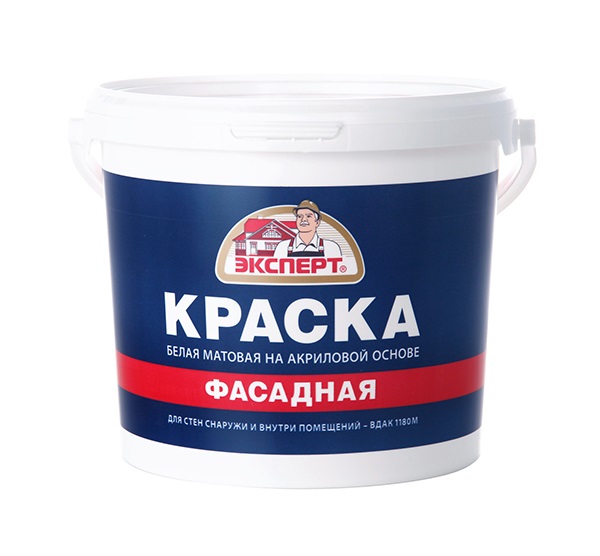
Why it is: A good combination of price and performance.
In terms of composition and performance, this paint is similar to the previous one in the rating, but at the same time it costs much less. However, it is focused on covering other materials. The manufacturer himself claims that this water-based acrylic facade paint is intended for use with plastered or plastered surfaces, asbestos-cement and gypsum plasterboards, bricks and cements, as well as chipboard and fiberboard.
For better stability, it is recommended to pre-prime the surface to be painted. Finishing materials of the 'Expert Fasadnaya' series, of course, themselves have excellent performance, but in combination with prepared bases, they provide maximum waterproofness and resistance to mechanical stress.
Matt, white, compatible with tinting pastes. Recommended for spray application, can be thinned.
Advantages
- Low price;
- Convenient packaging options;
- Good mechanical resistance and water resistance.
disadvantages
- Recommended for use on prepared surfaces;
- Slow complete drying (up to 4 weeks).
Tex PF-115
Rating: 4.7
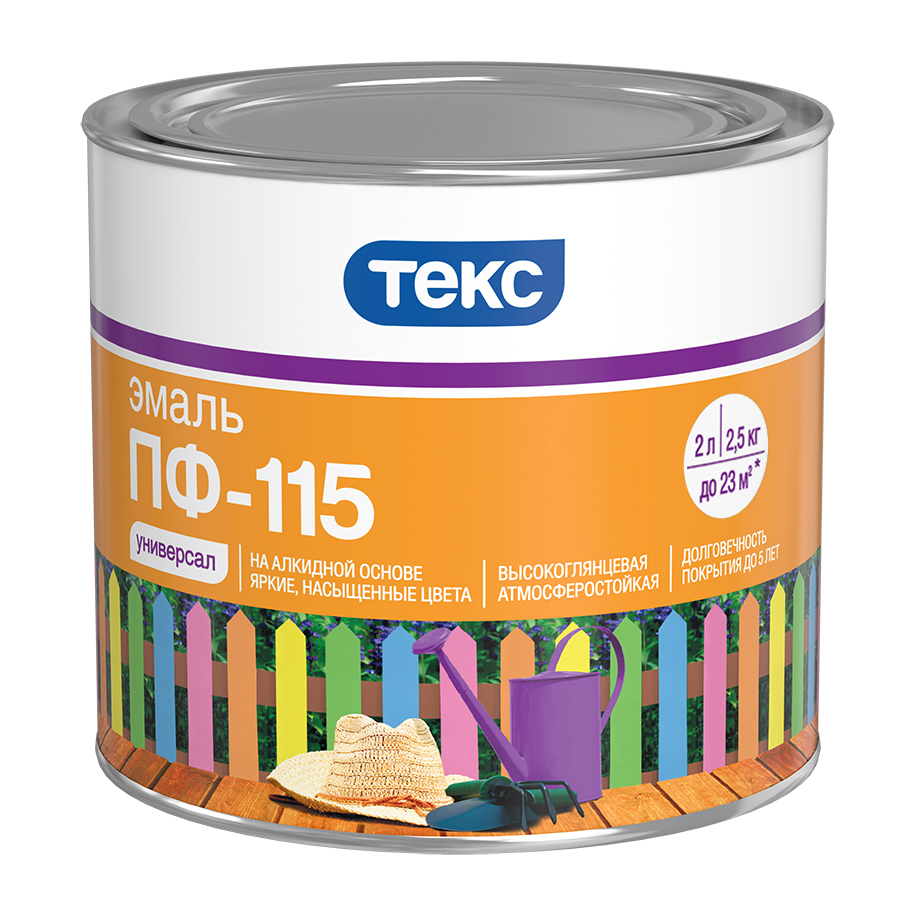
Why it is: Universal, suitable for all surfaces.
This acrylic enamel is suitable for most facade materials. It can be applied, according to information from the manufacturer, on surfaces made of unprepared (unprimed) wood, metal, plaster regardless of the wall base, sheets of drywall, fiberboard and chipboard.
Glossy. Differs in optimal reliability properties, resistant to mechanical, liquid and aggressive atmospheric influences. The adhesive characteristics are average, it is worth considering the small effect of the screed. Low vapor permeability, not recommended for use with plastered surfaces with lime mixtures.
Enamel from the manufacturer is presented in a wide range of colors. White paint supports tinting with suitable products. The operating period, according to official information, is up to 6 years.
Advantages
- Compatible with most materials;
- Bright colors, large factory palette;
- Good reliability indicators.
disadvantages
- Relatively short operational period;
- Very long drying time (layer drying – 5-7 hours).
Façade Deluxe Scanmix
Rating: 4.7
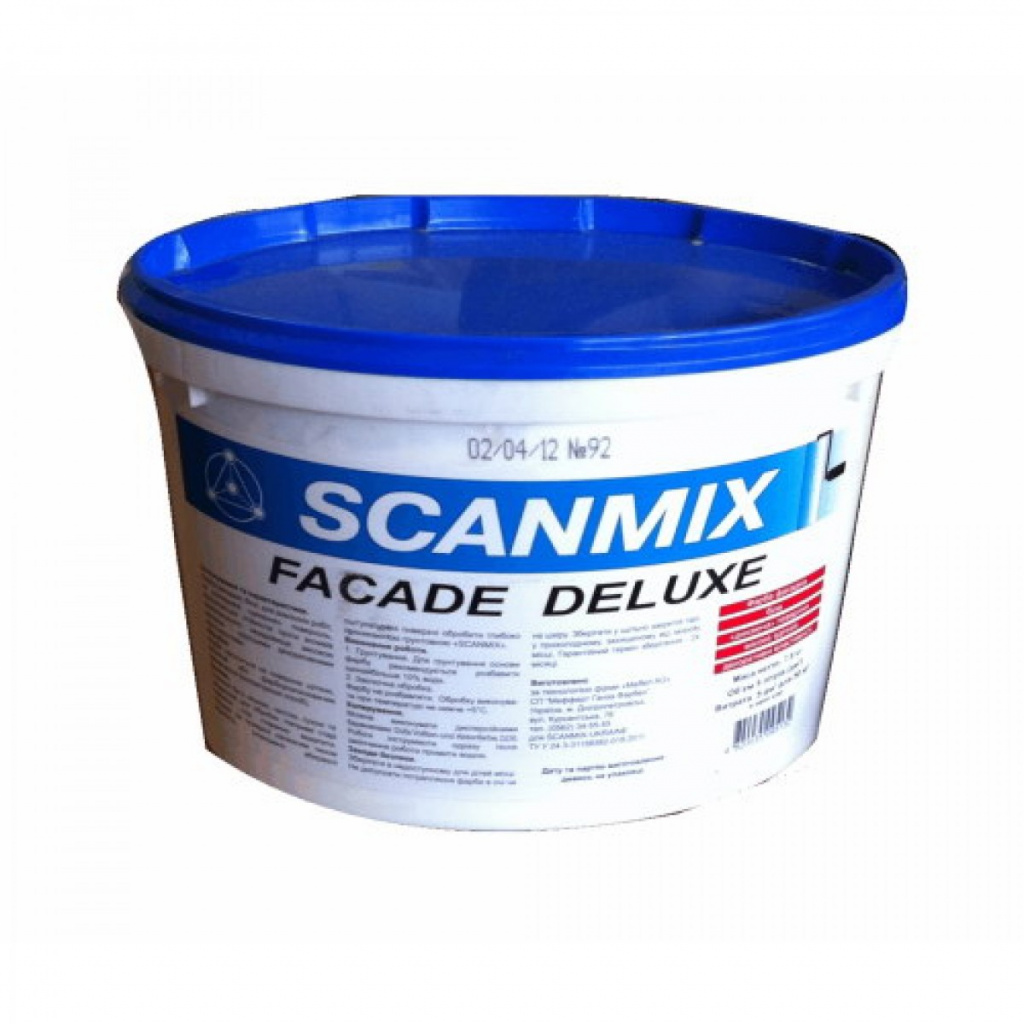
Why it is: Excellent performance silicone paint.
This facade paint is based on a silicone base, which makes it excellent for use on surfaces with constant aggressive environmental impact. It is distinguished by its hydrophobic properties, which do not allow moisture to penetrate into other finishing materials, repels dust and cleans itself from dirt on its own. In addition, due to its special composition, it slowly fade in the sun, ensuring the richness of the facade color for many years.
Suitable for almost all surfaces. It will be a good solution for decorating facades in which mineral wool is used as insulation. In this case, the paint will additionally protect it from moisture.
Matt. The stock color is white and can be tinted in various shades. Can be diluted with water up to 10% of the volume and applied with a brush, roller or spray gun.
Advantages
- Reliably retains color;
- Excellent waterproofing properties;
- Fast drying of the layer.
disadvantages
- Before applying to moisture-absorbing materials, they must be treated with a waterproofing primer;
- Slow complete drying.
- Needs a very thorough surface cleaning;
Caparol AmphiSilan-Plus
Rating: 4.6
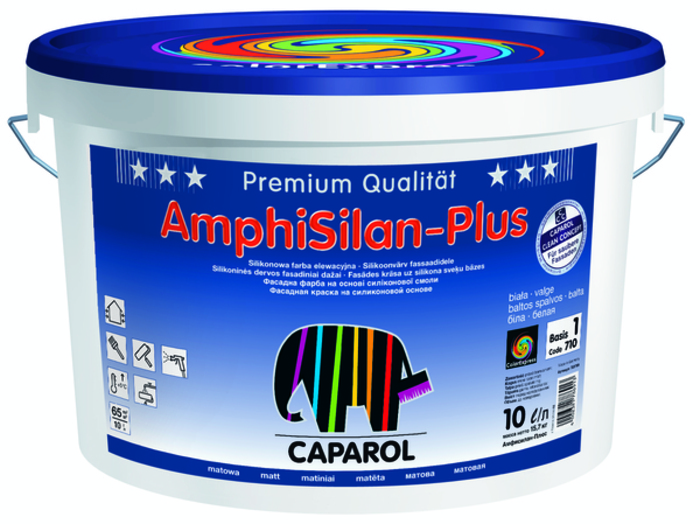
Why it is: Mineral facade paint with a silicone resin base.
This paint has some of the best hydrophobic properties in the rating. Thanks to the combination of a silicone base and mineral additives, it effectively repels moisture by capillary action, which makes it suitable for protecting even water-sensitive surfaces – for example, plasters on historic buildings during their restoration.
At the same time, the vapor permeability of the coating is excellent. As a result, this paint is also suitable for use on facades with composite thermal insulating liners, including mineral wool. Recommended for coating surfaces made of plaster and mineral materials.
Matt. Available in clear and white stock colors, but can be machine tinted using special dye additives. Supports application in any convenient way, including using a spray. Can be pre-diluted with water.
Advantages
- Excellent hydrophobicity;
- There is a basic transparent shade for the foundation;
- Resistant to mechanical and aggressive weathering.
disadvantages
- For best results, multi-layer application is recommended, which leads to paint wastage;
- Incompatible with wood and most untreated surfaces.
VGT VDAK 1180 SuperWhite
Rating: 4.5
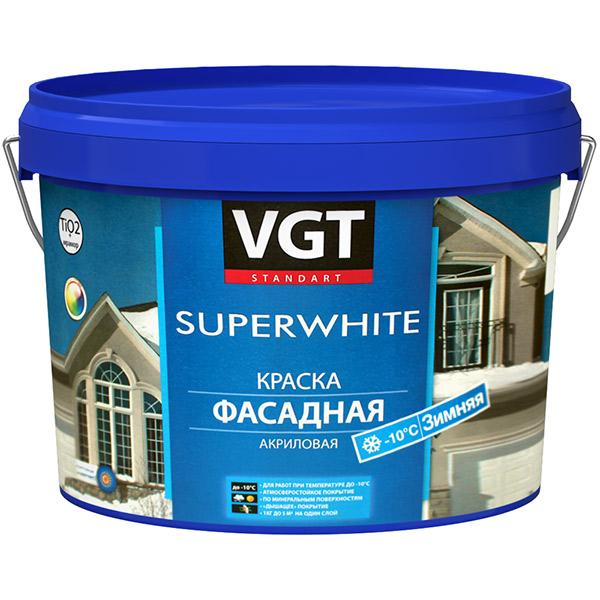
Why it is: Excellent waterproofing properties, bright white color.
The main advantage of this paint is an attractive stock (before tinting) shade. It has a rich, bright white color. Technically, it is acrylic enamel, therefore it is resistant to any aggressive influences leading to fading – an attractive shade will remain for a long time.
In addition, it is compatible with almost all coatings – from wood to concrete, ceramic and plasterboard. Provides good adhesion regardless of the substrate material. The excellent waterproofing properties of this paint make it possible to wash the surfaces to which it is applied and treat them with disinfectants. Suitable for use in hospitals and childcare facilities.
Matt. Supports tinting. Possesses good characteristics of vapor permeability and frost resistance.
Advantages
- Resistant to aggressive influences;
- Excellent waterproofing properties;
- Attractive pre-tinting shade.
disadvantages
- Relatively short operational period;
- Long drying of the layer;
- The manufacturer does not recommend using it on surfaces unprotected from aggressive weather conditions.
Akrial-Lux
Rating: 4.5
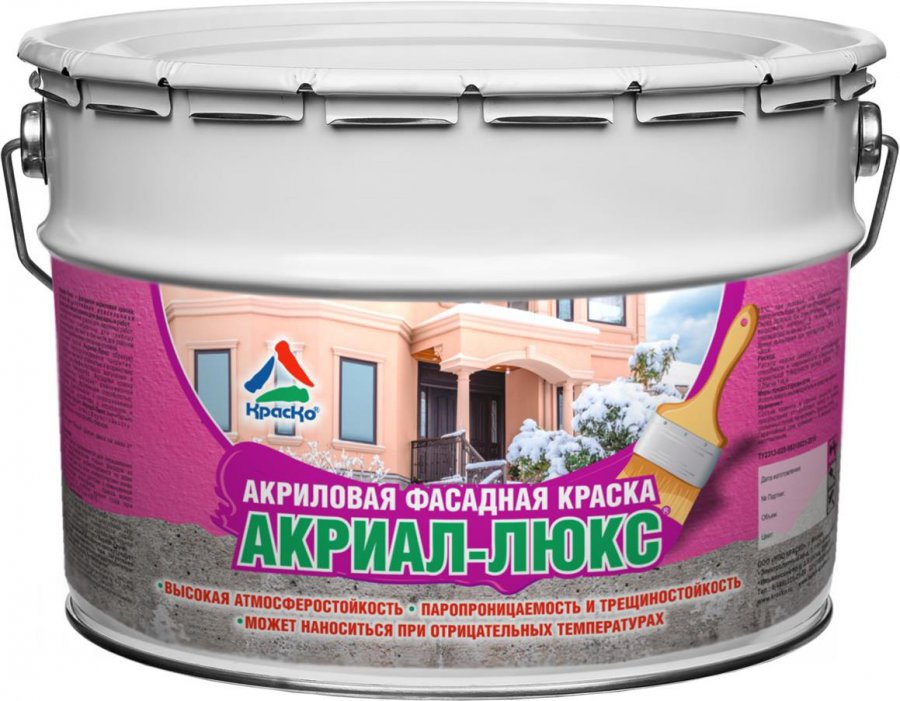
Why it is: Excellent resistance to negative weathering.
One of the most resistant to negative weathering facade paints in the rating. Thanks to the base of specially prepared acrylic resins, it can be applied at temperatures down to -15 degrees, and after drying, it supports operation in even more severe frosts. It also withstands extreme weather changes, including temperature drops, pressure, icing and much, much more.
Like other finishing materials based on acrylic resins, this one is distinguished by resistance to UV radiation (does not 'fade' under the influence of direct sunlight), waterproofing properties (even supports washing with disinfectants), mechanical damage and abrasion.
Designed for use on inorganic coatings. The manufacturer recommends using it on facades with all types of plaster. Differs in good flowability and low shrinkage parameters.
Advantages
- Supports application and operation at very low temperatures;
- Excellent strength parameters;
- Supports tinting.
disadvantages
- Not suitable for wood;
- Not suitable for unplastered surfaces;
- Only available in bulk.
Lacre
Rating: 4.5
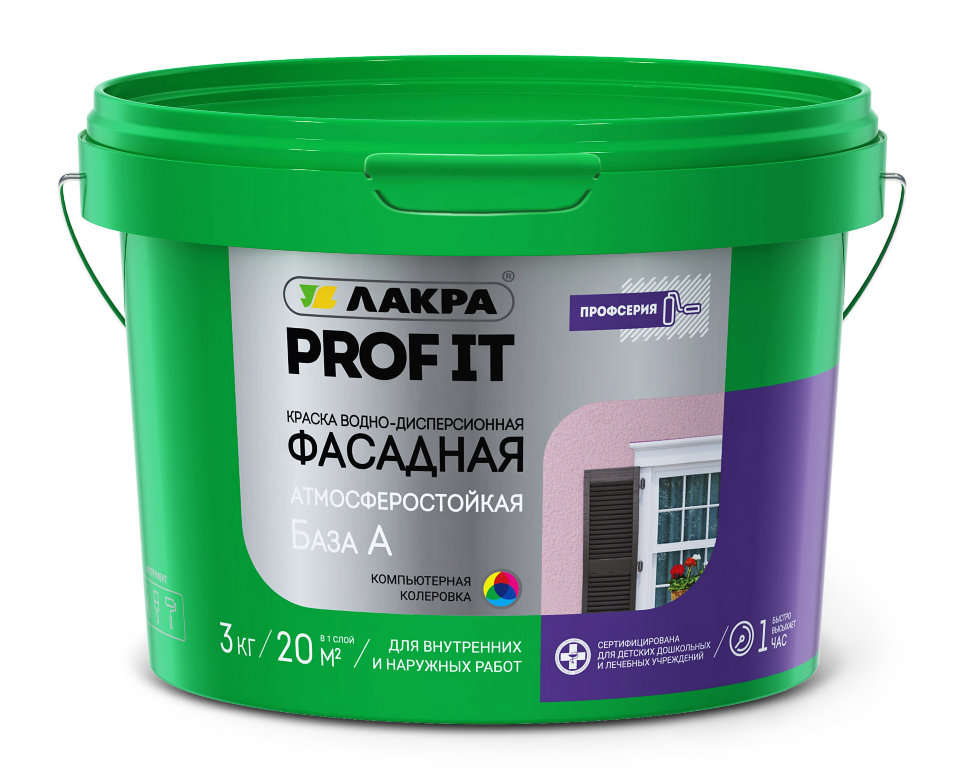
Why her: A line of professional facade paints.
The Lakra company produces a whole line of facade paints, differing in base (there are acrylic, siliconized and based on branded resins), but at the same time focused on professional use.
For example, the F60 grade is an acrylic-based finishing material intended for application to wood surfaces and characterized by increased adhesion. The F60 brand is based on 'elastic' acrylic resins, due to which it is resistant to the appearance of large and small cracks (it is able to stretch by 200% without loss of performance and visual qualities). The F51 brand uses the proprietary Degalan base, which supports all-season use and forms a super-resistant matte finish that retains its qualities under any aggressive influences, be it climatic or mechanical.
Thus, all of these materials have excellent performance characteristics.
Advantages
- Technological, well-developed composition;
- Wide range of solutions;
- Excellent strength characteristics.
disadvantages
- Not always uniform batch quality;
- Long drying time;
- Needs tinting (low saturation of the stock white color).
Attention! This rating is subjective and does not constitute an advertisement and does not serve as a purchase guide. Before buying, you need to consult with a specialist.

